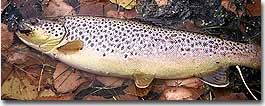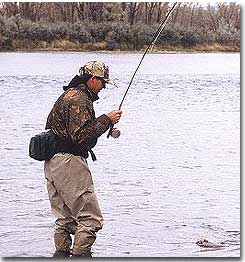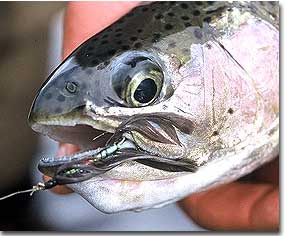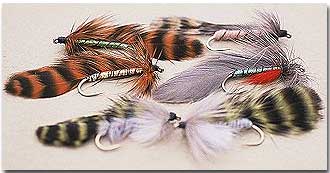Fishing When the Leaves Fall
Fishing When the Leaves Fall
By Bob Krumm
 If it weren't for the great fishing and bird hunting in late October through November and into December, I would absolutely hate this time of the year. With the cessation of daylight savings time, the afternoons become awfully short in this neck of the woods. If a storm front brings all day gray skies, I go into a deep funk.
If it weren't for the great fishing and bird hunting in late October through November and into December, I would absolutely hate this time of the year. With the cessation of daylight savings time, the afternoons become awfully short in this neck of the woods. If a storm front brings all day gray skies, I go into a deep funk.
Not only are most of the autumns leaves blown away, most of them have ended up on my lawn and I don't even have any major trees on my property. Late fall is not a great time of the year for me.
About the only way I perk up is to head to the nearby Bighorn River and pick on the brown and rainbow trout. The browns are getting ready to spawn or are spawning, while the rainbows are fattening up for the winter ahead. Essentially, it means both are aggressive in their feeding habits.
 It's the time of the year when there are still plenty of caddis and mayflies hatching along with some midges. An angler can spend the entire day fishing dry flies and see little to no drop in success rate. Or if an angler wants to go for numbers, they can fish nymphs imitating scuds, sowbugs, mayfly nymphs, or caddis emergers and end up catching enough trout to keep them happy for the rest of the winter.
It's the time of the year when there are still plenty of caddis and mayflies hatching along with some midges. An angler can spend the entire day fishing dry flies and see little to no drop in success rate. Or if an angler wants to go for numbers, they can fish nymphs imitating scuds, sowbugs, mayfly nymphs, or caddis emergers and end up catching enough trout to keep them happy for the rest of the winter.
For me late season fishing means one type of fishing only: streamer. Streamer fly fishing can be done when the wind is blowing a gale; it can be done when the temperature is below freezing; it can be done when an angler needs one memorable fish to carry him or her through the winter. Streamer fly-fishing parlays to the old fishing adage: Big Fish, Big Food.
If I am going fishing this time of the year, I want to get a hawg, a bragging fish and I know of no better way to achieve that goal than streamer fishing.
I like slinging a big Matuka across a riffle and letting it settle a bit and as the fly starts to swing, I start stripping in short, erratic strips. On a good day, I get a jolting strike every three or four casts; on a slow day I may only get a strike per 30 casts, but whatever the strike rate, the fishing is exciting.
 You see, I watch my clients fish nymphs darned near every day of the year. Toward the end of the season, watching a strike indicator is about as exciting as watching paint dry. Granted that nymph fishing is most always productive and you can catch big fish on nymphs, but nymph fishing really does require intense concentration. In order to be successful nymph fishing an angler needs to respond to the slightest perturbation of the meniscus (the slightest movement of the strike indicator on the water film). Concentration like that precludes a person from watching that flock of Canada geese flying by, or appreciating the last cottonwood with bright yellow leaves—in other words, a person has to watch that indicator all the time and can't enjoy what's going on.
You see, I watch my clients fish nymphs darned near every day of the year. Toward the end of the season, watching a strike indicator is about as exciting as watching paint dry. Granted that nymph fishing is most always productive and you can catch big fish on nymphs, but nymph fishing really does require intense concentration. In order to be successful nymph fishing an angler needs to respond to the slightest perturbation of the meniscus (the slightest movement of the strike indicator on the water film). Concentration like that precludes a person from watching that flock of Canada geese flying by, or appreciating the last cottonwood with bright yellow leaves—in other words, a person has to watch that indicator all the time and can't enjoy what's going on.
When I fish streamers, I can concentrate on where I'm casting, then after the fly has landed and sunk a bit, I can strip line while I let my eyes wander across the brown hillsides. Maybe I will see an antelope sneak by, a bald eagle soar above the river, a sharp-shinned hawk chase a song sparrow, or a mink lope along the bank. If I have a strike while I'm gazing about, it will be sharp enough to wrench me out of my reverie and stimulate me to set the hook. Not only is streamer fly-fishing effective, many times it's a no-brainer.
Since I like to fish with my 8 weight, 9 foot Sage RPL, I have plenty of rod to fight the fish hard and fast. Another thing I do is use only six to seven feet of leader tapered to 0X. Coupled with a size four heavy wire streamer hook, I can really lean on a fish. I fight them hard and fast, land them while they are still green with my rubber mesh boat net, back the de-barbed hook out, and release them in a couple of seconds.
Sometimes I will hold an especially well colored fish in the net in the water so I can appreciate the fish's beauty and maybe take a photo or two, but usually, I will have a sixteen-inch brown back in the water 15 seconds after I have hooked it.
Most of the time I prefer using a 10 or 12-foot sink tip line that is either sink rate III or IV. If I am wade fishing, I will cast across the current, mend upstream and let the line sink until the current is just starting to drag it, then I lower my rod and point the tip directly at the line and start stripping. Some days I find that evenly stripping the line in at about one six-inch pull per second is ideal. Other days, a three-inch pull-per-second might do, or even two six-inch pulls a second might work. Each time out, I have to experiment to find out what retrieve works best.
 I try to fish streamers that are close to the same color as the forage fish in the stream. My son, Clint, invented a pattern he called the "Hallmark Matuka" that really comes close to many of the baitfish in the Bighorn River. The body is pearlescent Mylar overlain with scud wrap while the wing is four paired and faced dun belly hackles. To top it off, Clint puts in a throat of red rabbit hair and six turns of dun hackle completes the fly. This pattern works well on both sunny and gray days.
I try to fish streamers that are close to the same color as the forage fish in the stream. My son, Clint, invented a pattern he called the "Hallmark Matuka" that really comes close to many of the baitfish in the Bighorn River. The body is pearlescent Mylar overlain with scud wrap while the wing is four paired and faced dun belly hackles. To top it off, Clint puts in a throat of red rabbit hair and six turns of dun hackle completes the fly. This pattern works well on both sunny and gray days.
I fish other Matuka patterns as well but I lean heavily on the Hallmark Matuka and blue dun Matuka (gray body, olive grizzly wing, white marabou throat, and blue dun hackle). Still there are days that a Clouser minnow with a yellow belly, black lateral line, and a brown back is a killer.
Many of my compatriots swear by wooly buggers in the traditional black marabou tail, olive chenille body and black hackle or go unconventional with a yellow and brown marabou tail, brown chenille body and a yellow hackle with a gold bead head. Ah, heck, they even throw in yellow rubber legs for extra movement. They catch plenty of fish on them, but I have a rough time slinging a lot of glitter, bells and whistles.
Though late season streamer fly-fishing is productive and fun, you must be careful not to injure yourself. Those cantankerous browns take a streamer so hard that they have been known to dislocate shoulders. If you have a shoulder condition, perhaps you should stay home and rake leaves (if you don't have any, you can do mine). Late season fishing is tough, but someone has to do it; it might as well be you. ~ Bob Krumm
|
